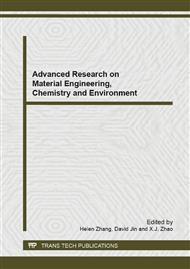p.95
p.100
p.105
p.110
p.114
p.119
p.127
p.132
p.136
Adsorption of In3+ from Aqueous Solutions by Persimmon Tannins-Immobilized Collagen Fiber
Abstract:
In the present work, a novel adsorbent to effectively adsorbed In3+ from an aqueous solution has been prepared by immobilizing persimmon tannin (PT) on collagen fiber. The adsorption capacities of In3+ on the immobilized PT were evaluated under various treatment conditions including the initial solution pH, solid-liquid ratio and temperature. The results showed that the effect of initial solution pH and solid-liquid ratio on the adsorption capacity were remarkable, while the influence of temperature was insignificant. The adsorption capacity reached 420 mg/g at 303 K and pH 5.0 when the initial concentration of In3+ was 100 mg/L and solid-liquid ratio was 0.2. The adsorption isothermal and kinetic data fitted best to the Freundlich model and the pseudo-second-order model, respectively.All these results indicated that adsorbent adsorbed efficiently and could be used as a low-cost alternative for the adsorption of In3+ in wastewater treatment.
Info:
Periodical:
Pages:
114-118
Citation:
Online since:
September 2013
Authors:
Keywords:
Price:
Сopyright:
© 2013 Trans Tech Publications Ltd. All Rights Reserved
Share:
Citation:


